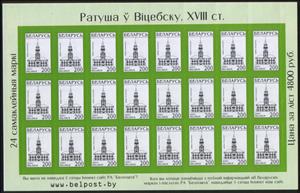Full Pane: Vitebsk - 18th century Building Self-Adhesive (Belarus 2001)
Vitebsk - 18th century Building Self-Adhesive (Belarus 2001)
29 March (Belarus ) within release Definitive Issue - Belarus Motifs (2001) goes into circulation Full Pane Vitebsk - 18th century Building Self-Adhesive face value 24*200 Belarusian ruble
| Full Pane Vitebsk - 18th century Building Self-Adhesive in catalogues | |
|---|---|
| Colnect codes: | Col: BY 2001.03.29-02a |
Full Pane is horizontal format.
COL BY 2001.03.29-02 The stamp (Security elements: microtext "БЕЛАРУСЬ", UV-protection: inscription in three lines - "БЕЛАРУСЬ / 2000 / BELARUS) was published in Two editions: 1. 2001-03-29. Printing run: 1 000 000 stamps (41 670 sheets). 2. 2001 September. Here is no logo on the reverse side of the sheet. Printing run: 1 000 000 stamps (41 670 sheets).Also in the issue Definitive Issue - Belarus Motifs (2001):
- Full Pane - Exhibition Centre - BelEXPO Self-Adhesive face value 24*100;
- Full Pane - Vitebsk - 18th century Building Self-Adhesive face value 24*200;
Full Pane Vitebsk - 18th century Building Self-Adhesive it reflects the thematic directions:
Architecture (Latin architectura, from the Greek ἀρχιτέκτων arkhitekton "architect", from ἀρχι- "chief" and τέκτων "builder") is both the process and the product of planning, designing, and constructing buildings and other physical structures. Architectural works, in the material form of buildings, are often perceived as cultural symbols and as works of art. Historical civilizations are often identified with their surviving architectural achievements.
A building or edifice is a structure with a roof and walls standing more or less permanently in one place, such as a house or factory. Buildings come in a variety of sizes, shapes and functions, and have been adapted throughout history for a wide number of factors, from building materials available, to weather conditions, to land prices, ground conditions, specific uses and aesthetic reasons. Buildings serve several needs of society – primarily as shelter from weather, security, living space, privacy, to store belongings, and to comfortably live and work. A building as a shelter represents a physical division of the human habitat (a place of comfort and safety) and the outside (a place that at times may be harsh and harmful).


